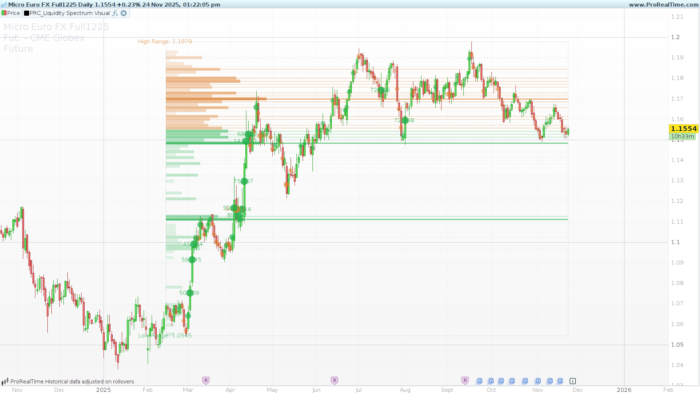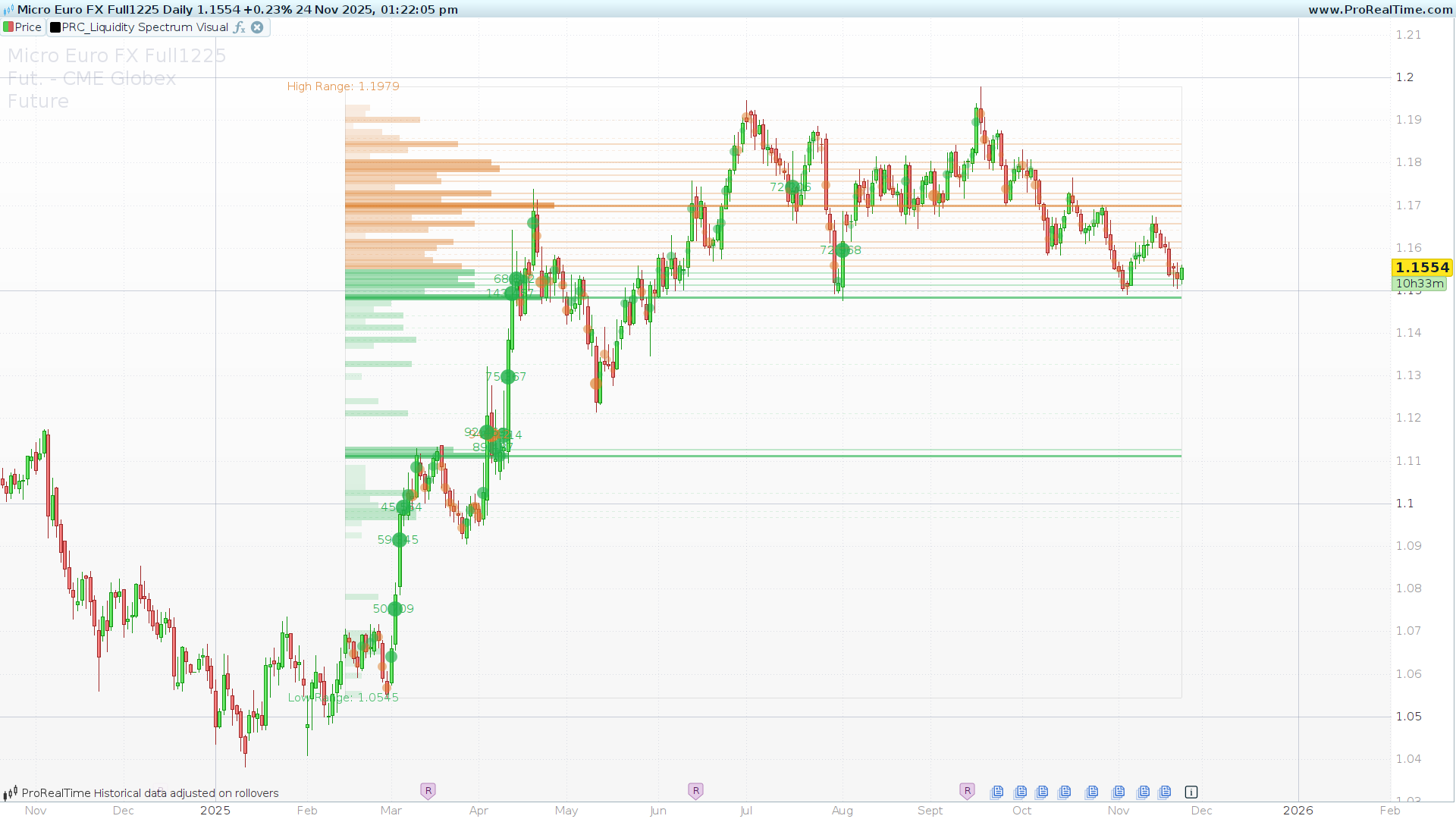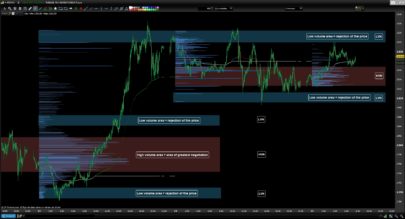Author: BigBeluga Date: 24.11.2025
Today, we are presenting the Liquidity Spectrum Visualizer, a comprehensive indicator developed by BigBeluga that combines statistical volume analysis with price-level liquidity mapping.
This tool does not just tell you when volume came in; it tells you where the liquidity is sitting and how significant the current activity is compared to historical norms.
The Concept: A Dual-Engine Approach
The power of this indicator lies in its hybrid engine. It processes market data in two distinct dimensions simultaneously: Time and Price.
1. Volume Bubbles (Time Dimension)
Standard volume bars can be noisy. To solve this, the indicator uses a Z-Score approach based on Standard Deviation.
-
It calculates the Standard Deviation of volume over a defined period (default is 200 candles).
-
It normalizes the current volume against that baseline.
-
The Result: Instead of arbitrary bars, you get Bubbles.
-
A small bubble means volume is within the normal deviation.
-
A massive bubble means volume is 3 or 4 standard deviations from the mean—a statistical anomaly indicating a major institutional event.
-
2. Liquidity Spectrum (Price Dimension)
Using the advanced Array functions available in ProBuilder, the indicator constructs a dynamic Volume Profile directly on your chart.
-
It divides the price range of the lookback period into 100 distinct “bins” or price levels.
-
It loops through historical data, assigning volume to specific price levels rather than specific times.
-
This creates a heat map of liquidity, showing you exactly at what price levels the most shares or contracts have changed hands.
Visual Interpretation
Understanding the chart visualizer is intuitive once you know the color coding and shapes:
1. The Bubbles (Market Aggression)
-
Size: Represents the statistical significance of the volume. A bubble size 4 is a rare, high-impact event.
-
Color:
-
Pine Green: The candle closed higher than it opened (Bullish pressure).
-
Pine Orange: The candle closed lower than it opened (Bearish pressure).
-
-
Labels: If a bubble is statistically extreme (Z-Score ≥ 4), the indicator prints the exact volume number on the chart, alerting you to potential exhaustion or breakout initiation.
2. The Liquidity Lines (Support & Resistance)
To keep the chart clean, the Volume Profile is represented by horizontal lines extending from the left. The style of the line indicates the strength of the liquidity wall:
-
Thick Solid Line: High Liquidity (High Volume Node). These are strong support/resistance levels.
-
Medium Line: Moderate liquidity.
-
Dotted Line: Minimal liquidity. These are “thin” zones where price can move through quickly (Low Volume Nodes).
Configuration and Settings
The indicator is designed to be “plug and play,” but it offers key customizable parameters to fit your trading style:
-
lookback(Default: 200): This defines how far back the indicator looks to calculate the Volume Profile and the Standard Deviation. -
showBubbles(1 or 0): Set to 1 to display the Volume Bubbles, or 0 to hide them if you only want the profile. -
showVP(1 or 0): Set to 1 to display the Volume Profile background. -
showLiqLevels(1 or 0): Set to 1 to draw the horizontal support/resistance lines based on liquidity.
Color Customization: The RGB color variables (rUp, gUp, bUp, etc.) are located at the top of the code. You can tweak these numbers to match your specific template (e.g., changing the Pine Green to a bright Neon Green).
The Code
|
1 2 3 4 5 6 7 8 9 10 11 12 13 14 15 16 17 18 19 20 21 22 23 24 25 26 27 28 29 30 31 32 33 34 35 36 37 38 39 40 41 42 43 44 45 46 47 48 49 50 51 52 53 54 55 56 57 58 59 60 61 62 63 64 65 66 67 68 69 70 71 72 73 74 75 76 77 78 79 80 81 82 83 84 85 86 87 88 89 90 91 92 93 94 95 96 97 98 99 100 101 102 103 104 105 106 107 108 109 110 111 112 113 114 115 116 117 118 119 120 121 122 123 124 125 126 127 128 129 130 131 132 133 134 135 136 137 138 139 140 141 142 143 144 145 146 147 148 149 150 151 152 153 154 155 156 157 158 159 160 161 162 163 164 165 166 167 168 169 170 171 172 173 174 175 176 177 178 179 180 181 182 183 184 185 186 187 188 189 190 191 192 193 194 195 196 197 198 199 200 201 202 203 204 205 206 207 208 209 210 211 |
// -------------------------------------------- // PRC_Liquidity Spectrum Visualizer by BigBeluga // version = 0 // 24.11.2025 // Iván González @ www.prorealcode.com // Sharing ProRealTime knowledge // -------------------------------------------- // Definable parameters (Initial configuration) // -------------------------------------------- lookback = 200 // Analysis period showBubbles = 1 // 1 = Yes, 0 = No showVP = 1 // 1 = Yes, 0 = No (Volume Profile) showLiqLevels = 1 // 1 = Yes, 0 = No (Liquidity levels) // -------------------------------------------- // Color Configuration (RGB) // -------------------------------------------- // Bullish Color (Pine Green type) rUp = 34 gUp = 177 bUp = 76 // Bearish Color (Pine Orange type) rDn = 221 gDn = 126 bDn = 42 // ------------------------------------------------------------- // 1. VOLUME BUBBLES CALCULATION // ------------------------------------------------------------- // Calculate volume standard deviation volStdev = STD[200](Volume) // Normalize volume (Simplified Z-Score) // Avoid division by zero nVol = 0 IF volStdev > 0 THEN nVol = Volume / volStdev ENDIF // Determine point size based on volume magnitude ipointSize = 0 IF nVol >= 1 AND nVol < 2 THEN ipointSize = 1 ELSIF nVol >= 2 AND nVol < 3 THEN ipointSize = 2 ELSIF nVol >= 3 AND nVol < 4 THEN ipointSize = 3 ELSIF nVol >= 4 THEN ipointSize = 4 ENDIF // Determine bubble color rDraw = rDn gDraw = gDn bDraw = bDn IF Close > Open THEN rDraw = rUp gDraw = gUp bDraw = bUp ENDIF // Calculate opacity based on size (larger = more opaque) alpha = 50 + (ipointSize * 40) if alpha > 255 THEN alpha = 255 ENDIF // Use typical price (HLC3) for location myPrice = (High + Low + Close) / 3 // Draw bubbles IF islastbarupdate and showBubbles THEN for i=0 to lookback-1 do // Determine point size based on volume magnitude using historical data IF nVol[i] >= 1 AND nVol[i] < 2 THEN DRAWPOINT(barindex[i], myPrice[i],2) COLOURED(rDraw[i], gDraw[i], bDraw[i], alpha[i]) ELSIF nVol[i] >= 2 AND nVol[i] < 3 THEN DRAWPOINT(barindex[i], myPrice[i],3) COLOURED(rDraw[i], gDraw[i], bDraw[i], alpha[i]) ELSIF nVol[i] >= 3 AND nVol[i] < 4 THEN DRAWPOINT(barindex[i], myPrice[i],4) COLOURED(rDraw[i], gDraw[i], bDraw[i], alpha[i]) ELSIF nVol[i] >= 4 THEN DRAWPOINT(barindex[i], myPrice[i],5) COLOURED(rDraw[i], gDraw[i], bDraw[i], alpha[i]) ENDIF // If volume is extreme (>=4), place text label IF nVol[i] >= 4 THEN myvol=volume[i] DRAWTEXT("#myvol#", barindex[i], myPrice[i]) ANCHOR(TOP,INDEX,VALUE) COLOURED(rDraw[i], gDraw[i], bDraw[i], 255) ENDIF next endif // ------------------------------------------------------------- // 2. VOLUME PROFILE AND LIQUIDITY LEVELS // ------------------------------------------------------------- IF showVP AND IsLastBarUpdate THEN // Find maximum and minimum of the lookback range highestPrice = Highest[lookback](High) lowestPrice = Lowest[lookback](Low) // Define size of each 'box' or bin (100 levels) priceRange = highestPrice - lowestPrice stepSize = priceRange / 100 // Clear volume bins array UNSET($volBins) // LOOP 1: Fill bins with volume // Loop through the last 'lookback' candles backwards FOR j = 0 TO lookback - 1 DO // Get close price and volume of that historical candle histClose = Close[j] histVol = Volume[j] // Calculate which array index corresponds to this price // Index 0 is the lowest price, 99 the highest binIndex = FLOOR((histClose - lowestPrice) / stepSize) // Protect array limits (0 to 99) IF binIndex < 0 THEN binIndex = 0 ELSIF binIndex > 99 THEN binIndex = 99 ENDIF // Accumulate volume at that price level if IsSet($volBins[binIndex]) THEN $volBins[binIndex] = $volBins[binIndex] + histVol ELSE $volBins[binIndex] = histVol ENDIF NEXT // Find maximum volume to scale the drawing (normalization) maxBinVol = ArrayMax($volBins) // Visual offset (places the VP start at the beginning of the lookback) offset = -lookback // LOOP 2: Draw profile FOR i = 0 TO 99 DO // Define Y coordinates (Prices) yBottom = lowestPrice + (stepSize * i) yTop = yBottom + stepSize yMid = (yTop + yBottom) / 2 // Get level volume currentBinVol = 0 IF IsSet($volBins[i]) THEN currentBinVol = $volBins[i] ENDIF // Calculate bar length (max 50 candles width) barLength = 0 IF maxBinVol > 0 THEN barLength = ROUND((currentBinVol / maxBinVol) * 50) ENDIF IF barLength > 0 THEN // Determine level color (if current price is above or below this level) rLvl = rDn gLvl = gDn bLvl = bDn IF Close > yMid THEN rLvl = rUp gLvl = gUp bLvl = bUp ENDIF // Simulated gradient with transparency // More volume = more opaque alphaLvl = ROUND((currentBinVol / maxBinVol) * 150) + 20 // RECTANGLE DRAWING (Volume Profile) // Draw from the past anchor point to the right DRAWRECTANGLE(barindex + offset, yTop, barindex + offset + barLength, yBottom) COLOURED(rLvl, gLvl, bLvl, alphaLvl) BORDERCOLOR(0,0,0,0) // LIQUIDITY LEVELS DRAWING (Poc Extensions) // If volume is significant (>25% of max), extend a line IF showLiqLevels AND (currentBinVol / maxBinVol) > 0.25 THEN if (currentBinVol / maxBinVol) > 0.75 THEN // Small horizontal line marking the liquidity level (High significance) DRAWSEGMENT(barindex + offset, yMid, barindex , yMid) STYLE(LINE, 3) COLOURED(rLvl, gLvl, bLvl, 155) elsif (currentBinVol / maxBinVol) > 0.50 THEN // Medium significance DRAWSEGMENT(barindex + offset, yMid, barindex , yMid) STYLE(LINE, 2) COLOURED(rLvl, gLvl, bLvl, 70) elsif (currentBinVol / maxBinVol) > 0.40 THEN // Low significance DRAWSEGMENT(barindex + offset, yMid, barindex , yMid) STYLE(LINE, 2) COLOURED(rLvl, gLvl, bLvl, 55) else // Minimal significance (Dotted) DRAWSEGMENT(barindex + offset, yMid, barindex , yMid) STYLE(LINE, 1) COLOURED(rLvl, gLvl, bLvl, 35)style(dottedline) endif ENDIF ENDIF NEXT // Range Maximum and Minimum labels DRAWTEXT("High Range: #highestPrice#", barindex + offset, highestPrice) ANCHOR(BOTTOM,INDEX,VALUE) COLOURED(rDn, gDn, bDn, 200) DRAWTEXT("Low Range: #lowestPrice#", barindex + offset, lowestPrice) ANCHOR(TOP,INDEX,VALUE) COLOURED(rUp, gUp, bUp, 200) // Draw analysis box background drawrectangle(barindex+offset,highestPrice,barindex,lowestPrice)coloured("grey",50) ENDIF RETURN |
Share this
No information on this site is investment advice or a solicitation to buy or sell any financial instrument. Past performance is not indicative of future results. Trading may expose you to risk of loss greater than your deposits and is only suitable for experienced investors who have sufficient financial means to bear such risk.
ProRealTime ITF files and other attachments :PRC is also on YouTube, subscribe to our channel for exclusive content and tutorials




